Why get a fire pit? Everyone has flowers and trees in their garden, but not everyone has a fire fit. More than providing warmth, a fire pit can become the social hub outside your house, the place to gather with family and friends on cool evenings and nights. There are many types of fire pits around, so it’s not hard to find one that suits your style and budget. In this guide, you’ll learn everything you need to know about fire pits to make an inspired choice.
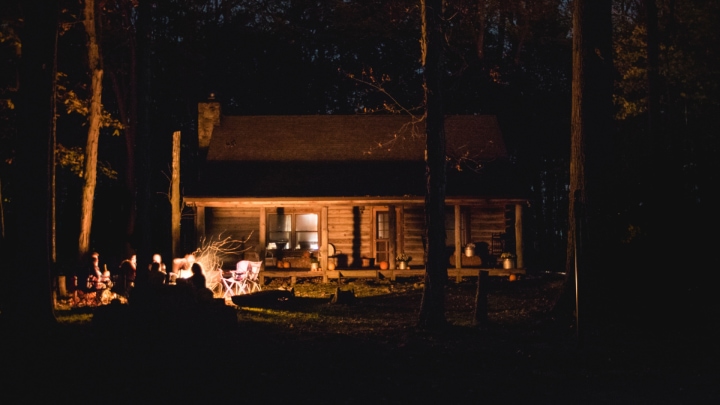
Whether you’re a home-dweller or a more outdoorsy type, it’s hard to deny that an open fire has a charm of its own. An outdoor fire pit can easily become the centerpiece in your garden.
Fire pits are a chic and safe way to capture those enticing flames and bend them to your will while you sip a drink and have some good time with your friends or family. The best part? Finding one that’s right for you or even building it yourself isn’t all that hard.
What Is a Fire Pit?
A fire pit is designed to nurture and contain a fire in a safe and secure environment. Fire pits take many forms, from the basic hole in the ground to a complex, indoor metal or stone structure that doubles as an interior design piece.
Functions
For our ancestors, the main purpose of the fire pit was simple: to provide warmth. Indeed, in an age when indoor heating was non-existent, people relied on an open fire to keep them from freezing in the cold night.

Nowadays, the purpose of a fire pit is, in many cases, decorative, since most homes have indoor heating installed.
Still, the fire pit remains a popular source of heat, particularly on cold winter nights. In some cases, the open fire also allows you to cook simple dishes and treats, such as marshmallows, and also serves as a wonderful social hot spot.

There really isn’t anything like gathering in front of the fire pit with your friends and family on a cool evening, exchanging stories, or even watching a movie.
A fire pit is also a highly romantic piece–who doesn’t long to share a bottle of wine with their loved one in front of the open fire?
The takeaway: A fire pit can serve many purposes, some of them practical, and many of them entertaining.
Materials
One of the most important aspects of building a fire pit on your property is that you construct it properly and safely. First of all, you will need materials that can withstand high temperatures and open flames for a prolonged period.
Many modern fire pits are constructed with fire brick and fire mortar on the inside so that the inner walls of the fire pit don’t catch alight when you lit the fire.

The exterior of the pit, however, doesn’t need to be built with fire-proof materials, though of course, you shouldn’t opt for easily flammable structures (such as wood), either.
Tip: Traditionally, stone, bricks, metal, and poured concrete are the most popular materials to use when building your fire pit.
Naturally, once you’ve settled on what materials to use for the structure of the fire pit, you need to consider the inside, also.
For example, you’ll want your fire pit to have a steel fire ring, also known as a gas ring. This will ensure that the flames come in a more or less even layer.

Often, you can modify and adjusted gas rings to suit the effect and mood you desire. While you can, of course, leave the gas ring open, it’s prettier to cover it up with some filler material. This also absorbs the heat and makes it radiate more evenly.
Note: Common fill materials include lava rock, recycled glass, or river rock. Fill materials help “capture” the heat, but their main purpose is decorative, and to make the fire seem more “authentic.”
Fuels
In the olden times, open fires used to run on dry wood, straw, and pretty much any other flammable the person could get their hands on. Nowadays, there are four common types of fire pits, distinguished chiefly by the type of fuel they use:
Wood
Wood is still one of the most common and obvious fuels for your fire pit. Wood logs are easy to get and fairly inexpensive, and they are nice on the eye.
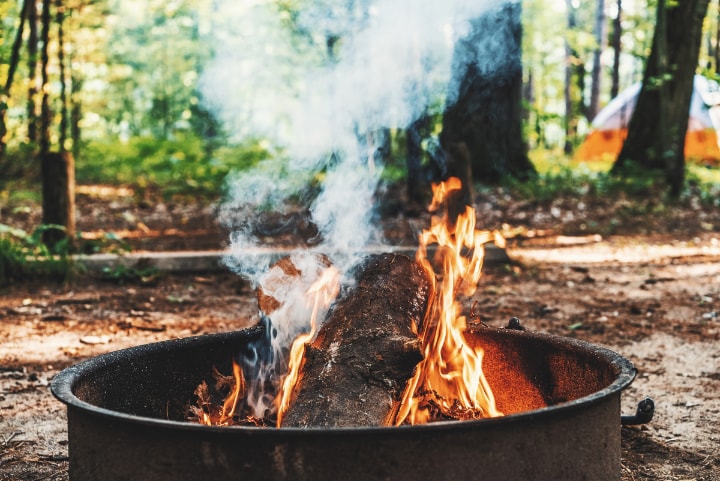
The human brain associates fire with wood, since for many years, that’s what humanity used to make fire. So, a wood-burning pit is definitely the most traditional.
Propane
Liquid propane gas (LPG) is a clean-burning type of fuel that is a more eco-friendly alternative. It’s easy to transport in tanks since it has a low boiling point and easily turns to gas.

It’s also easy to use, although, like other gases, it has a distinctive smell, which is added to it to increase safety.
Gas
Also referred to as natural gas (NG), this is another great alternative to wood. Natural gas is typically found in coal beds, when oil is extracted, or in marshes, where there is decaying organic matter.
Unlike LPG, natural gas is difficult to transport, which is why it’s mainly delivered to homes through piping.
Charcoal
Alternatively, charcoal makes for a great fuel to your pit, although it will invariably create smaller flames than the other fuels.

Naturally, there are other types of fuel one might use to ignite a flame, but these four are by far the most popular ones for creating a proper fire pit.
Ethanol
Lastly, we have the fire pit that uses alcohol to burn. This type of pit creates a pretty, enticing flame, and is easier to fuel than other types of pits.
Although there is quite a bit of fear associated with the alcohol-powered fire pit, the truth is that they are just as safe to burn indoors as any other type of fuel.
Gel
Gel fuel is a type of chemical that does not produce any smoke or odor. It’s particularly popular for smaller, table top fire pits, as it’s generally considered a safe fuel.
Features to Consider When Choosing Fuel
All the above fuel options are reliable, effective, and most importantly, safe. Here are some features to consider when choosing the right fuel for you:
- Convenience – If you play to have a wood-burning pit, you’ll need to get regular shipments of fuel delivered to your home. If you’re going with natural gas, you’ll be able to easily light the fire, since the gas is transported through pipes straight to your pit.
- Vibe – No other fuel can come close to that unique crackling sound of a wood-burning pit. However, an ethanol flame has a more clean, modern appearance. When choosing the type of fuel, you’ll want to consider the overall atmosphere you’re aiming for–are you more traditional, or do you want something new and modern?
- Costs – The upkeep of a fire pit can be quite pricey. If you’re looking for a cheap option, then wood logs are probably the way to go, since natural gas fires can pump up your gas bills something awful.
Types of Fire Pit
In this section, we’ll have a closer look at the different types of fire pit available.
First of all, we’ll look at the ones we mentioned earlier, distinguished by the type of fuel used.
We will also discuss indoor fires vs. outdoor, and pretty much any other type of pit you can dream of.
Gas Fire Pit
The gas fire pit is a popular choice for many, as it closely resembles other familiar home structures, such as the gas stove.

Important: The main benefit of a fire pit that runs on natural gas is that you can have it pulled through pipes straight to the pit, and so don’t need to worry about running out of fuel.
Another benefit of the gas pit is that it is safer when compared to a wood pit because its flames are not as large and tend to be easier to control. It also doesn’t give off that woody, burnt smell.
Since gas pits have fewer restrictions attached to them, they are ideal for gardens as well as small indoor spaces.
They are, however, more expensive, both in upkeep and in installation. As opposed to a wood-burning pit, a gas one will require valves, piping, ignition, hoses, you get the idea.
Propane Fire Pit
Interestingly enough, propane is actually a by-product of natural gas that comes about during the process of gas processing and petroleum refinement. That being said, a propane fire pit has very similar benefits to a gas one.

Its flames are more controllable and do not produce sparks and flying embers. Once again, these are ideal in smaller spaces, but can also be used outside for barbecues.
Good to know: Perhaps the best part of a propane pit is that it doesn’t require any piping, like the gas pit, and so isn’t as expensive to install. It also allows you to change its location.
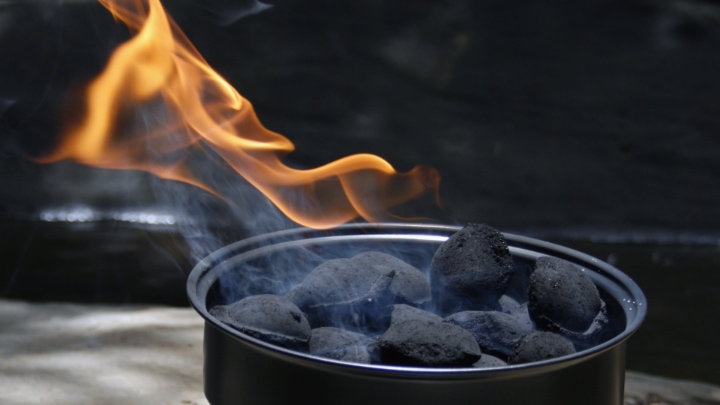
One major minus, however, of propane pits is that propane tends to be denser than natural gas, and has a tendency to sink to the ground if there isn’t proper ventilation in the room. This can pose quite a serious fire hazard.
But the propane pit seems to offer endless reasons why it’s the right pit for you. For example, propane has more than twice the usable energy that natural gas does.
It’s also friendly to the environment, much like natural gas, because it emits very few toxins during burning.
Wood Burning Fire Pit
By far the most traditional option out there, the wood-burning pit is still a popular choice for many homeowners. The wood-churning fire pit has several benefits attached to its name. It is, first of all, the cheapest and simplest pit you could have.
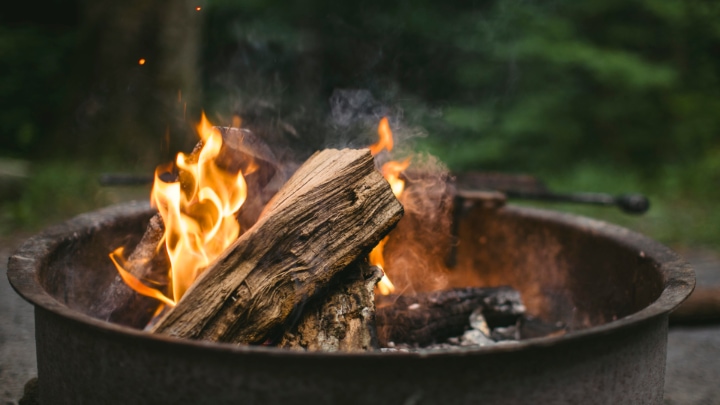
All you need is a non-flammable enclosure (metal bowls are a popular option), some wood logs, and that’s it. You’ve got yourself a fire pit, without all the messiness and expense of running gas pipes and the like.
Wood pits have a lot going for them: they’re cheap, easy to construct, and maintain, and are very appealing to our inner caveman. But there are also a few downsides to them.
For one thing, wood-burning fire pits give off a denser smoke, which can be unpleasant if placed too close to a patio or terrace.
Warning: You also need to be more careful with wood-burning pits, since they can throw lit sparks and embers outside of the fire enclosure. This means you should keep it well away from any flammable surface, such as a wooden patio, for example.
Electric Fire Pit
Electric fire pits are perhaps the most versatile out of the bunch. An electric fire pit works either through fan heating or infrared fire. The way the fan heater works is by running an electric current through a metal coil, which leads to the coil heating up.

Good to know: The infrared fire, on the other hand, works through invisible rays of light that travel straight in one direction and heat the objects in their path (rather than stimulating them to heat themselves, like a fan heater would).
Now, the major downside is that it is quite obviously artificial. It’s very modern and looks beautiful, with many electric fires now including artificial flames, but it just does not have that authentic open fire feel (mainly because it isn’t).
On the other hand, electric fire pits are great if you are living in a home with small children or pets and you worry about their safety around an open fire. These pits are also a lot safer since there is no chance of flying embers or a gas leak.
So really, it’s a question of, do you choose the enticement of a real fire or do you chose safety?
Table Fire Pit
A more modern take on the classic camp fire, the table fire pit is essentially a table with a built-in fire pit in the middle. It’s charming to look at and makes for the perfect decoration, both inside the home and out.
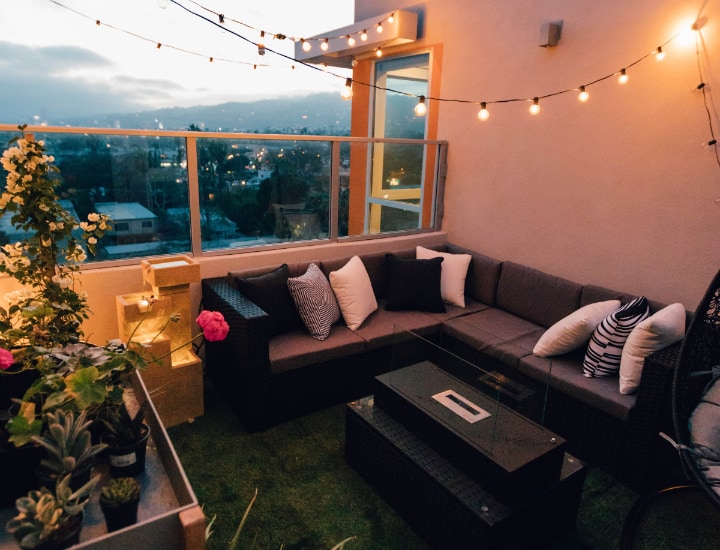
Normally, a table fire pit runs on either gas or propane, so the rest of the table can easily be built out of wood, replicating a regular table.
Good to know: The main appeal of a table fire pit is that while it does not generate as much heat as a fire pit would, it does offer some warmth, while you enjoy coffee, a few drinks, or even a meal on the side of the fire.
Table fire pits come in a wide array of styles, shapes, and sizes. They can be as small as a coffee table and go up to bar-height. Round, oval, rectangular, you name it—you can probably find a table fire pit to fit any design style you wish.
Outdoor Fire Pit
When contemplating an outdoor fire pit, bear in mind that you can either opt for a mobile one, such as the table pit we just spoke of, or a more stationary, square our round pit, with the outsides typically build out of stone or brick.
For an outdoor one, wood is an excellent choice for fuel, as the smoke does not accumulate, as it would indoors.

There is also less chance of a fire, as long as you set the fire pit a good way away from any flammable surface (e.g. deck chairs, patios, or trees).
Remember: An outdoor wood-burning fire pit will give the exact feeling of a traditional campfire, as well as make for a nice centerpiece for a night spent reminiscing with friends.
If stone doesn’t appeal to you, you can opt for a stainless steel, stationary pit. The main advantage of this one is that it’s resistant to heat as well as rain.

Portable Fire Pit
Portable fire pits can run on pretty much any type of fuel, from wood logs to propane, and can even be electric.
They go well both outside and indoors and are more efficient since you can take them from one room to another and enjoy the pretty flames anywhere you wish.

They look great outdoors since you can have one on your porch or patio, provided that it runs on gas or propane. Besides, the main thing to consider about a portable fire pit is that you don’t need as much space.
Really, when opting for a stationary pit, either indoors or outdoors, you are giving up a massive amount of space. And while that’s fine in big homes and yards, it’s not the kind of space you can always spare.
A portable pit can take any shape you like–a fire bowl, urn, or a table top fire pit.

Good to know: A table top fire pit is different from an actual table fire pit because it does not include the table. It’s simply a fire-proof piece, inside of which you can light a fire that runs on gel fuel.
Gel fuel is odorless and inexpensive and the table top fire is so light and safe that you can use it anywhere.
Fire Pit with Cover
It’s usually a good idea to cover outdoor fire pits when you are not using them, to keep them protected from the elements (gas fire pits, for example, risk rusting if exposed to damp).

It’s also crucial that you cover your outdoor pit to prevent any critters or insects from settling into your fire pit, and potentially damaging the structure.
Even if you live in dry weather or it’s not a particularly rainy day outside, it’s still best to protect your pit from UV rays, which begin to surreptitiously damage the materials of the pit as soon as it’s installed.
DIY Fire Pit
So far, we talked mainly about types of pits you can buy at the store. But it’s also possible to build your fire pit.
It is, obviously, much cheaper, and offers you more choice of material and style, so that you can create the perfect pit to suit your needs.

Important: Some fire pits are more difficult to build than others. For example, a gas pit is difficult, as it required piping and expertise that most DIY enthusiasts simply lack.
Still, in the guide below, we will be showing you how you can build your own indoor or outdoor fire pit easily and safely.
Not interested in DIY fire pits? Simply scroll on down for our ultimate fire pit buying guide.
Best Ideas for a Fire Pit
Brick Pit with a Brick Wall
Brick is perhaps the best, non-flammable, and elegant looking material to use when building your pit. But have you thought about where you might sit to admire it?

While you’ve got your bricks and mortar and everything, consider going all Stonehenge on your yard and build a small wall for you and your family to sit around the fire.
Copper Concrete
Concrete works great for building a fireplace. It’s perfectly safe and adds a tint of color to your fire pit.
Match with Your Seats
Regardless if you’re building it indoors or outside, chances are you’ll want to sit and admire your work at some point.

And most people have the seating before they get the pit, so make sure you match the style of the pit with that of your seating for a more uniform outlook.
Add a Twinkle of Light
Sure, an open fire is a great source of light, but often, adding a low overhanging light can make the atmosphere even cozier.
Hanging lights make for wonderful backyard decoration, and make every night feel special.
Stone it up!
Stones are another exceedingly popular material for building fire pits.

So when you’re making your pit, consider adding (or buying) a matching stone bench, that you can then cozy up with throw blankets and pillows. Check out this blog for more fire pit ideas and inspiration.
How to Make Your Own DIY Fire Pit
Before you get digging, you want to check with the safety regulations in your area, to see what you can and can’t do. Also, make sure you give your utility company a ring, to ask about any buried pipes and lines.

Things You’ll Need
- cement
- gloves
- water
- tools to mix the cement with and in (such as disposable bowls or buckets)
- a can of gel fireplace fuel
- lava rock
Important: You will also want to figure out the ideal size of your pit and get setting bowls for it. You’ll need a big plastic bowl (as big as you want your pit to be), and one that is smaller (around half the size), to create the actual pit.
Step 1
Simply mix the cement to a good, thick consistency, and pour it into the larger bowl.
Step 2
Next, scoop in the smaller bowl, to create an indenture, and leave to sit for about 70-90 minutes. Don’t be afraid to level it or adjust in any way necessary.
Step 3
Once the cement has hardened, remove the smaller bowl first, then give it another half an hour to sit.
Step 4
After that, you can remove the pit from inside the bowl, add the fireplace fuel in the middle, the lava rock around, and voila!
For a detailed guide to building a concrete outdoor pit, check out this useful video tutorial:
Fire Pit Buying Guide
If you’re not feeling adventurous enough to build your own fire pit, don’t worry. Below, we have the right fire pit buying guide for you.
Location
The first thing you need to consider is the desired location of your pit. Not only is this necessary so that you can match the pit to the rest of your furniture, but it also matters because some fire pits are meant exclusively for outdoor use.
Warning: Some fire pits, such as wood-burning ones, can cause the accumulation of toxic fumes and gases indoors and pose a health hazard.
Size
You also want to measure the designated area. A large backyard, for example, can easily house a large 50” fire pit.

If you’re looking for something for your patio, a 30” one will do.
Even if your patio is reasonably large, a 40” fire pit can look bulky and out of place on it, so you want to have the precise measurements before you hit the store.
Use
Another important feature to consider is what purpose you want your fire pit to have.
Are you going to use it for barbecues? Then you might want to look for one with a fitted grate, or at the very least, with an option to purchase one.

If you want the family to enjoy a meal around the fire, then a table pit might be the way to go.
Lastly, if you want a purely decorative pit, then you don’t need to bother with a grate or designated eating area.
Accessories
Depending on the type of fire pit you choose, you may also be able to buy some accessories to go with it.
For example, a wood-burning pit can come with a spark screen, to prevent lit embers and sparks from flying. It can also come with a wood grate beneath the wood logs for better air flow.

Tip: When shopping for a fire pit, always check what accessories they offer.
Cost
The cost will also vary depending on the type of fire pit you want. While a small, indoor pit can cost only a few hundred dollars, the price of a proper, big pit can go up to thousands of dollars, depending on materials, working rates, and job complexity.
The cost of hiring someone to build you an outdoor pit can range from $300 to $1,400 and averages somewhere around $700. But it really depends on where you live.
Best Fire Pits for Sale
Don’t have time to build your own fire pit? No problem. You can find lots of great options for sale. We’ve handpicked some of the best for you. Discover them below!
Outland Firebowl Pit
This outdoor fire pit is propane-powered and easy to take with you anywhere you go: to the beach, glamping, or even in your own backyard. It’s just small enough to fit anywhere and just big enough so you can do some light cooking over it.
Endless Summer Pit
This rectangular pit is also highly mobile and creates an unusual, appealing effect with its green-tinted glass that contrasts the propane-powered flame. It’s also a great source of heat—so just perfect for chilly nights.
Sunnydaze Cosmic Outdoor Pit
This one is great for a more traditional feel, as it actually burns wood logs, instead of propane. It’s also larger, making it ideal for barbecues. At the same time, it’s pretty safe as it comes with a special spark screen.
Fire Pit Safety Tips
As we’ve seen, a fire pit can serve multiple purposes. It can be both efficient and beautiful at the same time.
But easily the most important thing around a fire is safety, so here are some tips we ask you to keep in mind.

- Never build a fire under something. Whether it’s trees or the roof of your patio, an open fire can easily light it up and can potentially burn the entire house down, not to mention endanger you and yours.
- Don’t use construction wood for burning, as it has been treated with all sorts of chemicals and adhesives that will fill the air.
- Keep water nearby. Or, if you prefer, a fire extinguisher. Even if the pit is built perfectly safe, there is the possibility of the fire spreading. You need to be sure you’re ready to extinguish it.
- Watch yourself. Ensure your hair is tied up (if you have long hair) when setting or coming near a fire. Likewise, ensure you don’t wear loose, flowy clothing.
- Keep flammable furniture a safe distance. Deck chairs and benches love to burn. Don’t give them the opportunity!
- Never leave a fire unattended. Not even if it’s dying down. If you must leave the premises, even for a minute or two, ask someone to guard it while you’re gone.
Fire Pit FAQ
What is the best fire pit?
The best fire pit for you depends really on your preferences. If you prefer a more traditional fire, than a stone or brick pit that burns wood is the way to go. If you’d rather have a safer, more modern fire pit, either opt for propane or go electric.
Where can I buy a fire pit?
You can order one online or shop for it directly at a furniture or outdoor store. Discover now our recommendations on the best fire pits for sale.
What does a fire pit do?
A fire pit can provide heat during cold weather. It can help you cook things outdoors. Or it can serve as a decorative piece. Learn more here.
Can you have a fire pit in your backyard?
Of course. In fact, your backyard is by far the safest place for a fire pit. There is less risk of inhaling smoke or of things catching fire. However, you should always check your local regulations to see whether there are any limitations to having an open fire on your property.
Fire Pits Can Light a Spark for Anyone
Overall, fire pits are an excellent addition to your home, regardless if you’re looking to spruce up your garden or simply make your backyard more cozy and interesting.

Naturally, different types of pits will appeal to different people–so which one was most appealing to you?
Are you going to go traditional with a wood fire pit or go electric instead? And what about the materials? Stone, steel, or something else?
We’d love to hear from you in the comments below!

Leave a Reply